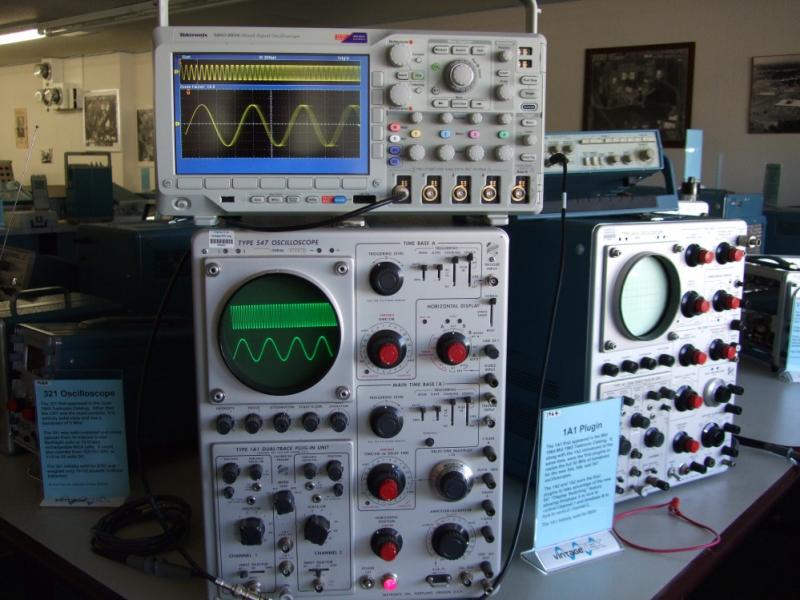

When the Curiosity rover landed on Mars, I was reminded of the moon landings of the late ‘60s and early ‘70s. Like many engineers my age, I grew up obsessed with the Apollo program. I thought it might be interesting to compare a scope that engineers and scientists would have used to put astronauts on the moon to the design tools we have today. In the late ‘60s, a lucky engineer would have probably had a Tektronix 547 DC-to-50 MHz oscilloscope on their bench. Today, a well-equipped engineer is likely to have a scope like the MSO3034 Mixed Signal Oscilloscope.
The first problem was finding a Tek 547 in prime condition. This gave me a good reason to visit the VintageTEK Museum in Portland, Ore. where they have a 547 (and many other Apollo-era instruments) in pristine working order. You can see many photos the instruments on display and the tube-savvy engineers who maintain the equipment at the VintageTEK website.

To launch our evaluation, we ran the same frequency sweep into both the current-day MSO3034 and Apollo-era 547. Note that both scopes show the frequency modulation and both are able to “zoom” in to see detail at the beginning of the sweep. Even though the displays are similar, the two instruments process the signal in very different ways. The 547 conditions the input signal and applies it to the vertical plates on its cathode ray tube. It shows the frequency modulation as a wider, fainter trace due to the behavior of the phosphor of the CRT. (Unfortunately it doesn’t show up very well in the photo.) The MS3034 digitizes the signal, stores the waveform to memory thousands of times per second, and writes the memory to the display. It also shows the modulation as a wider, fainter trace, but the effect is accomplished using digital signal processing. The 547 shows the detail at the beginning of the sweep by using a second analog timebase to display the signal at a faster rate. The MSO3034 uses digital pan and zoom functions to display signal details.
Both instruments are great tools for visualizing most electronic signals. One should resist the temptation to get overly nostalgic, though. The modern scope gives us:
- Color display with on-screen readouts
- Single-shot acquisition (without using a Polaroid camera)
- Waveform storage and transfer
- Search, pan and zoom through thousands of screens of waveform information
- Display analog traces and digital timing traces together
- Decode and display serial bus information
- USB and LAN interfaces for data transfer and remote control
- Automatic measurements, cursors, FFT
- Self-test, automatic signal path compensations, and closed case calibration
These features just weren’t possible in a bench scope, given the state of technology in the late ‘60s. However, the 547 did a lot of the same basic functions as the MSO3034, and the two instruments were specified in more or less similar terms. Here’s a comparison:
|
|
Tektronix 547 (with 1A1 plug-in) |
Tektronix MSO3034 |
|
Bandwidth |
50 MHz |
300 MHz |
|
Risetime |
7 ns |
1.17 ns |
|
Sample Rate |
none (or infinite, depending on your bias) |
2.5 GS/s |
|
Record Length |
None |
5 M points |
|
Input Sensitivity Range ( per div) |
5 mV to 20 V |
1 mV to 10 V |
|
Horizontal Scale (per div) |
10 ns to 5 s |
1 ns to 1000 s |
|
Vertical Graticule |
6 div |
8 div |
|
Triggers |
Edge |
Edge, Sequence, Pulse Width, Timeout, Runt, Logic, Setup and Hold, Rise/Fall Time, Video, Serial Bus, Parallel Bus |
|
Waveform Math |
Add, subtract |
Add, subtract, multiply, divide, integrate, differentiate, FFT, expressions with constants, sin, cos, sqrt, exp, log, ln and parametric measurements like period, freq, rms, etc |
|
Max Input V |
600 V DC + peak AC |
300 Vrms (< 450 V peak) |
|
Analog Input Channels |
2 |
4 |
|
Digital Input Channels |
- |
16 |
|
Timebases |
2 |
1 |
|
Weight |
71.5 lb |
9.2 lb |
|
Power Consumption |
510 W |
120 W |
|
Price |
$2,500 in 1968 ($16,485 in 2012 dollars) |
$13,700 |
Obviously the MSO3034 wins in a spec-to-spec showdown, but the Tek 547 was an amazing instrument in its day. After more than 40 years, the beam on the CRT was crisp and clear. Even though the crew from vintageTek did most of the driving, the controls were pretty easy to understand once I remembered the difference between alternate and chop. And the 547 had a few tricks the modern scope couldn’t match. The two-channel vertical amplifier is modular, so it can be upgraded or swapped out for repair. Other modules were also available to turn the instrument into a sampling scope, four-channel scope, spectrum analyzer, or time-domain reflectometer. It has two timebases, allowing you to display signals at two different rates. It has a built in calibration generator and current probe test loop.
I invite the fans of the 547 or other analog scopes to share some of their experiences with these instruments that helped put people on the moon. In spite of a fun morning using an instrument that was groundbreaking in its time, and appreciating the accomplishments of an earlier era, I’m not going to give up my digital storage scope anytime soon.
Since publishing the above blog, Tektronix is currently offering discounts up to 89% on software application modules for qualifying oscilloscopes. Check out the details here and save away!


